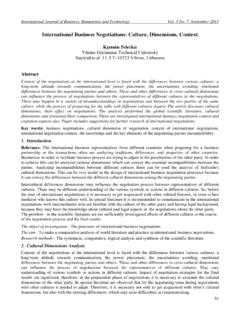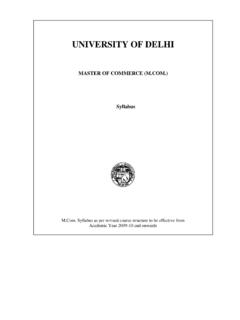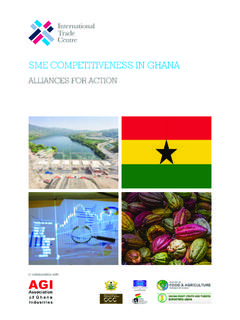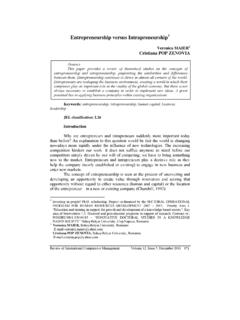Transcription of Draft Resource Mobilization Strategy
1 CoC IEE Working Groups I and III 1 July 2008. Draft Resource Mobilization Strategy 1. analysis of needs and FAO's comparative advantages 1. The Resource mix at the disposal of the Organization to carry out its work has been evolving, with extrabudgetary expenditure having risen to the same level as that under the Regular Programme (RP) in 2006-07. Nonetheless, the IEE found that: a) there are gaps in the funding of key areas; b) proposals for use of extrabudgetary resources do not systematically demonstrate how they will contribute to the Organization's agreed outcomes and outputs, and that improvements are needed to ensure that extrabudgetary funds complement the Regular Programme to achieve corporate targets and results; c) there is the need to better integrate requirements arising from national, sub-regional and regional programmes; and d) there are issues about the volatility and earmarking of current extrabudgetary funding. 2.
2 The IEE recommended that a coherent and dynamic Resource Mobilization Strategy should be put in place around Impact Focus Areas (known as Priority Themes in the IEE Report) and national medium-term priority frameworks. This document presents a possible Strategy for consideration by CoC-IEE Working Groups I and III. 3. FAO's requirement for a sound, stable and strengthened funding base derives from its role as a centre of technical excellence in the areas of its mandate. FAO's main comparative advantages for Resource Mobilization are: Role in providing balanced, evidence-based contributions to complex and sensitive debates at global, regional, sub-regional and national level;. Function as a neutral forum for the negotiation of international agreements;. The quality and calibre of technical staff who can become active catalysts of best practice'. development in the areas of the Organization mandate at country level;. Extensive presence at country, and sub-regional and regional level.
3 Field programme and implementation capability in complex situations and its access to Governments;. Recognized role with regards to emergency and transition/exit strategies from rehabilitation to development and investment;. Demonstrated capacity to partner. Vision and objectives 4. FAO aims for Resource Mobilization and communication efforts to be undertaken at all levels of the Organization to secure resources required for it to carry out its core functions and achieve the planned Organizational Results, at global, regional, sub-regional and national level. 5. The objectives of the Strategy for Resource Mobilization are: Adequate funding and support for the achievement of Organizational Results at the global, regional, sub-regional and country level;. Timely and predictable voluntary funding to be able to plan effectively FAO's work;. Increase the share of broadly earmarked funding. 1. CoC IEE Working Groups I and III 1 July 2008.
4 2. Charting the way forward - elements of the Strategy 6. To achieve these objectives, the elements of the Strategy will include a set of actions, some with external partners of FAO, and others of a more internal nature, based on two main principles incorporation of the planning and use of extrabudgetary resources in the new programming model covering all sources of funds, contributing to the achievement of Organizational Results;. delegation of authority for Resource Mobilization at decentralized level, with strong coordination from Headquarters based on a clear definition of roles. 7. The type of extrabudgetary resources that would support achievement of FAO's Organizational Results include: partnering and support in kind; official donor assistance whether through projects or programmes1, partnership programmes or direct reimbursement of expenditure;. application of direct budget support and unilateral Trust Funds. Elements of Description of actions Result implementation: A.
5 Embed the Resource The planned results of FAO activities Increase Mobilization Strategy in should give all members, donors and transparency and the new programming beneficiary countries confidence that Members' and model, with regional and the activities for which the donors' confidence sub-regional programmes Organization requests financial support in FAO. and NMPTFs to provide have been subject to thorough review strategic focus to Resource and directly contribute to the Mobilization at regional, formulated results of the Organization sub-regional and country for the biennium. The Resource level. envelopes presented Medium Term Plan and Programme of Work and Budget will provide the estimate of the extrabudgetary resources envelope. Regional and sub-regional programmes and NMPTFs to catalyze FAO Resource Mobilization at the regional, sub- regional or country level, in line with other country specific approaches2, including the Delivering as One pilot process.
6 B. Engage Members and Agree dedicated steps in the planning Increase donors in the process of process: a) Members to examine the overall predictability of defining the resources extrabudgetary requirements emerging from extrabudgetary envelope ranges from the MTP/PWB process as part of the resources by voluntary contributions proposal preparation, in a proposed Meeting planned of Members in the early part of year 2 of the Organizational biennial cycle; b) Inform and engage donors result. in support of the needs of FAO advocacy, normative, development or emergency and 1. SFERA. 2. UNDAF, PRSPs where relevant. 2. CoC IEE Working Groups I and III 1 July 2008. rehabilitation activities, and report on the level of resources pledged, received and allocated versus planned requirements through a set calendar of consultations during the implementation cycle. C. Present Impact Focus Impact Focus Areas help catalyze the Facilitate and Areas, in the context of the Mobilization of extrabudgetary increase pooled and new SF/MTP planning resources.
7 They represent flagship' un-earmarked process for Members' areas of work defined for the immediate funding review future or to reflect emerging challenges. They contribute to the achievement of the SOs, and relate to resources for uptake of products and services FAO. commits to deliver to Members, as generally defined in the Organizational Results. Impact Focus areas can represent areas of comparative advantage or core functions of the Organization where there is a known Resource gap for the attainment of results at regional, sub- regional and country level at the level expected. D. Significantly raise Develop a comprehensive marketing Enhanced awareness among policy communication Strategy and plan recognition and makers, potential donors focusing on key donor audiences and appreciation of the and the general public of based on concrete success stories. FAO Brand . FAO's unique Widely promulgate the marketing among key donor contribution to the communication Strategy and plan to audiences3.
8 Development process, its ensure coherent communication of key comparative advantage in messages related to Resource emergency operations and Mobilization . rehabilitation, and its Develop a related set of communication effectiveness in guidelines for staff in all units to assist implementing donor- them in engaging in communication funded projects and activities related to Resource programmes. Mobilization . E. Reach out and engage a Document and monitor donors' trends Enlarge funding broader range of and new and share the information with all base, taking account emerging donors, offices involved in Resource of partnership including consideration of Mobilization . Regional and Sub-regional contributions. the private sector; Organizations and institutions, and other Coordinate closely with UN Organizations especially at country relevant partners and level, are partners for possible expand partnerships resourcing of Joint Programmes under FAO's areas of mandate.
9 Examine pragmatic opportunities arising from the private sector; develop 3. Linked to an understanding of the Organization's comparative advantages as an implementer of donor-funded projects and programmes 3. CoC IEE Working Groups I and III 1 July 2008. guidelines for review by Governing Bodies for engaging in Resource Mobilization with the private sector. Develop the Resource Mobilization component of the Partnerships Strategy . Recipient Governments to demonstrate their engagement in full partnership with FAO activities by honouring their financial commitments such as GCCC. F. Encourage donors to Determine a programme of recognition Facilitate a results move gradually from and ensure donor visibility suitable for based approach and project approach to multi the donor and the circumstances. increase pooled and year strategic Develop new frameworks for multi-year un-earmarked /partnerships and/or to and/or multi-donor longer term and less funding support the impact focus conditioned funding, unilateral trust areas.
10 Funds, joint programmes, national execution and other non-traditional emerging donors including the private sector;. Improve business intelligence reporting internally and to Members and donors on results achieved, resources, beneficiaries leveraging the/or in complementarity with Organizational monitoring and assessment systems. G. Articulate clear roles for Decentralized offices to: Achieve effective Decentralised Offices and a) advocate FAO comparative advantage at organizational Headquarters in support regional, sub-regional and country level; arrangements in of Resource Mobilization b) contribute to and inform the formulation support of Resource of Organizational Results and identification Mobilization , of Impact Focus Areas; including among c) Mobilize resources for the results regional, sub- formulated for the regions, sub-regional and regional and the country offices; country offices. d) Allocate resources received and results and provide feedback to central coordination and to local partners and donors.
















